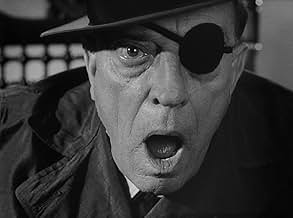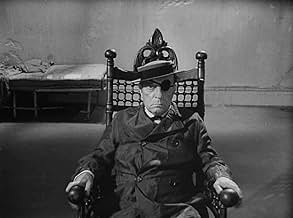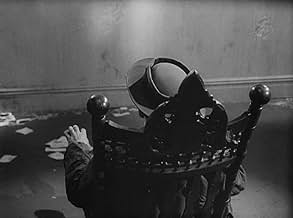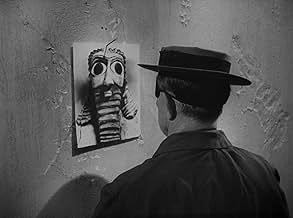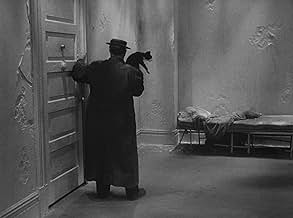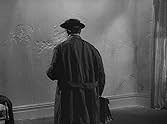Füge eine Handlung in deiner Sprache hinzuA twenty-minute, almost totally silent film (no dialogue or music, save one 'shhh!') in which Buster Keaton attempts to evade observation by an all-seeing eye. But, as the film is based arou... Alles lesenA twenty-minute, almost totally silent film (no dialogue or music, save one 'shhh!') in which Buster Keaton attempts to evade observation by an all-seeing eye. But, as the film is based around Bishop Berkeley's principle 'esse est percipi' (to be is to be perceived), Keaton's ver... Alles lesenA twenty-minute, almost totally silent film (no dialogue or music, save one 'shhh!') in which Buster Keaton attempts to evade observation by an all-seeing eye. But, as the film is based around Bishop Berkeley's principle 'esse est percipi' (to be is to be perceived), Keaton's very existence conspires against his efforts
- Regie
- Drehbuch
- Hauptbesetzung
Empfohlene Bewertungen
Keaton was mystified by this script, too, as by "Godot", but wanted the money. He suggested several comedic bits be added, because he thought the whole thing would be less than five minutes. In New York, he wanted to use one of his flat hats rather than the bowler Beckett had written in, and Beckett immediately agreed.
The film was shot in mid-summer in a very hot New York, each day over 90 degrees. Keaton (age 69, and not in great health: he died less than two years later) never complained as he had to keep running along that brick wall in the heavy overcoat.
It was Beckett's only visit to the U.S., and he never got outside of New York, and left the U.S. as quickly as possible.
This experimental short was written by Samuel Beckett, and directed by his frequent stage collaborator Alan Schneider. The actor they cast in the lead was not their first choice for the role, but his haunting presence is a key reason why this film called "Film" is still remembered and frequently screened today: the old man is 68 year-old Buster Keaton, who at this point in his career was more commonly seen in TV commercials, variety show guest shots, and occasional movie cameos. This was not at all a typical gig for Buster, nor was it a routine project for Beckett, who was more inclined to write for the stage or radio. Beckett had wanted to work with Keaton several years earlier, when he offered him the role of Estragon in the American stage premiere of "Waiting for Godot," but Buster turned it down and the role went to Bert Lahr. It's said that Buster didn't understand "Godot" and had misgivings about this script as well, but for whatever reason he agreed to star in Beckett's first movie. It's a good thing, too, for even with his face hidden he brings dignity, comic nobility, and the weight of his personal history to the proceedings. Keaton represents his era, carrying the mantle of the battered but unbowed silent clown in this all-but-silent movie. Aside from a single sound effect (a whispered "Sh-h-h-h!") the soundtrack is entirely silent, while the grainy black-and-white stock used for filming is evocative of early cinema. What happens here is not really suggestive of Buster's own early work, but there is a beautifully characteristic sequence when the old man tries to put out his dog and then his cat, only to have each animal slip back in as he attempts to put out the other. Both Beckett and Schneider pronounced themselves more than pleased with Keaton's performance: the latter called him "magnificent."
My reaction to this movie has changed with the passage of time. When I first saw it years ago I found it interesting, but also kind of exasperating; I was frustrated I couldn't see Buster's expression. Now I'm struck by the film's directness and simplicity, and recognize that even a glimpse of the old man's face along the way would kill the impact when the moment of truth finally arrives. Samuel Beckett told an interviewer that the movie was "about a man trying to escape from perception of all kinds -- from all perceivers -- even divine perceivers." In between takes on the set near the Brooklyn Bridge the lead player told a reporter something similar, summarizing the theme as "a man may keep away from everybody but he can't get away from himself." I can't say it better than that and I'm not going to try. I'll simply note that we can be grateful Buster Keaton agreed to take part in this unusual project, a seemingly unlikely collaboration that in my opinion has aged beautifully.
Beckett's work at that time was slowly gaining ground in Norway, as did Pinter's - trying to promote either was an uphill task in a mountainous country unused to modern drama and more tuned to sports. The discussions in a seminar after the showing proved this... But this resistance to something obviously alien did not detract from my pleasure (and several others') in relishing a masterpiece, where nothing could have been improved on. A book called "Film by Samuel Beckett" was published by Faber in 1971, and generously offers complete scenario and a profusion of illustrations and production shots. It has also comments by Beckett and an essay by Schneider, and is a useful substitute for anybody without access to the Film itself.
Agreeing with other commentators, I can only say that this is really an absorbing and disturbing experience - quite unique! And one that leaves you thinking and wondering and shuddering for a long time.
Wusstest du schon
- WissenswertesThe story of making "Film" was the basis of a play "The Stone Face" by Sherry MacDonald. The play was read in Orlando at the 2006 New Playfest, and work shopped at the 2007 New Playfest.
- VerbindungenFeatured in Zomergasten: Folge #3.3 (1990)
Top-Auswahl
Details
- Laufzeit
- 20 Min.
- Farbe
- Sound-Mix
- Seitenverhältnis
- 1.37 : 1

